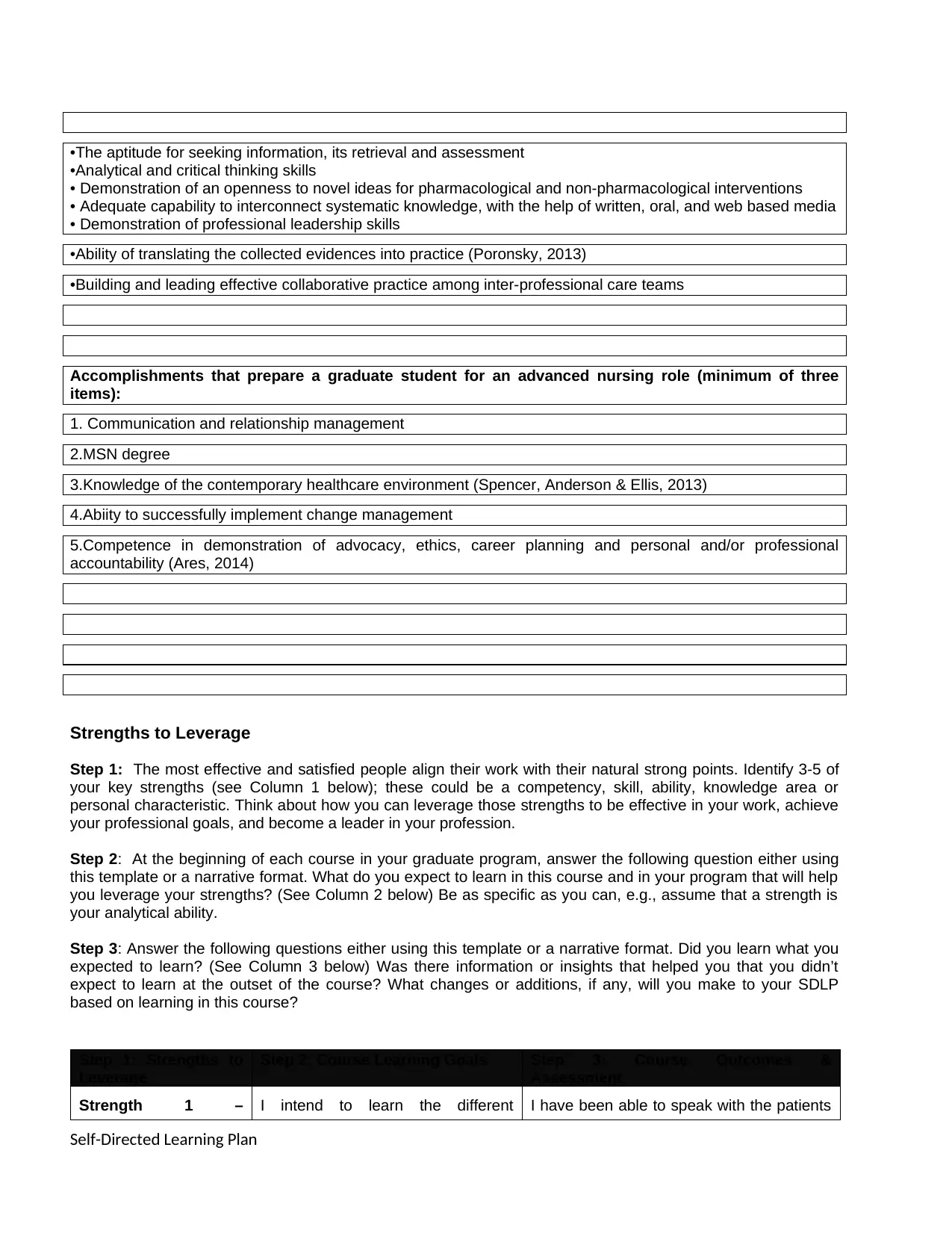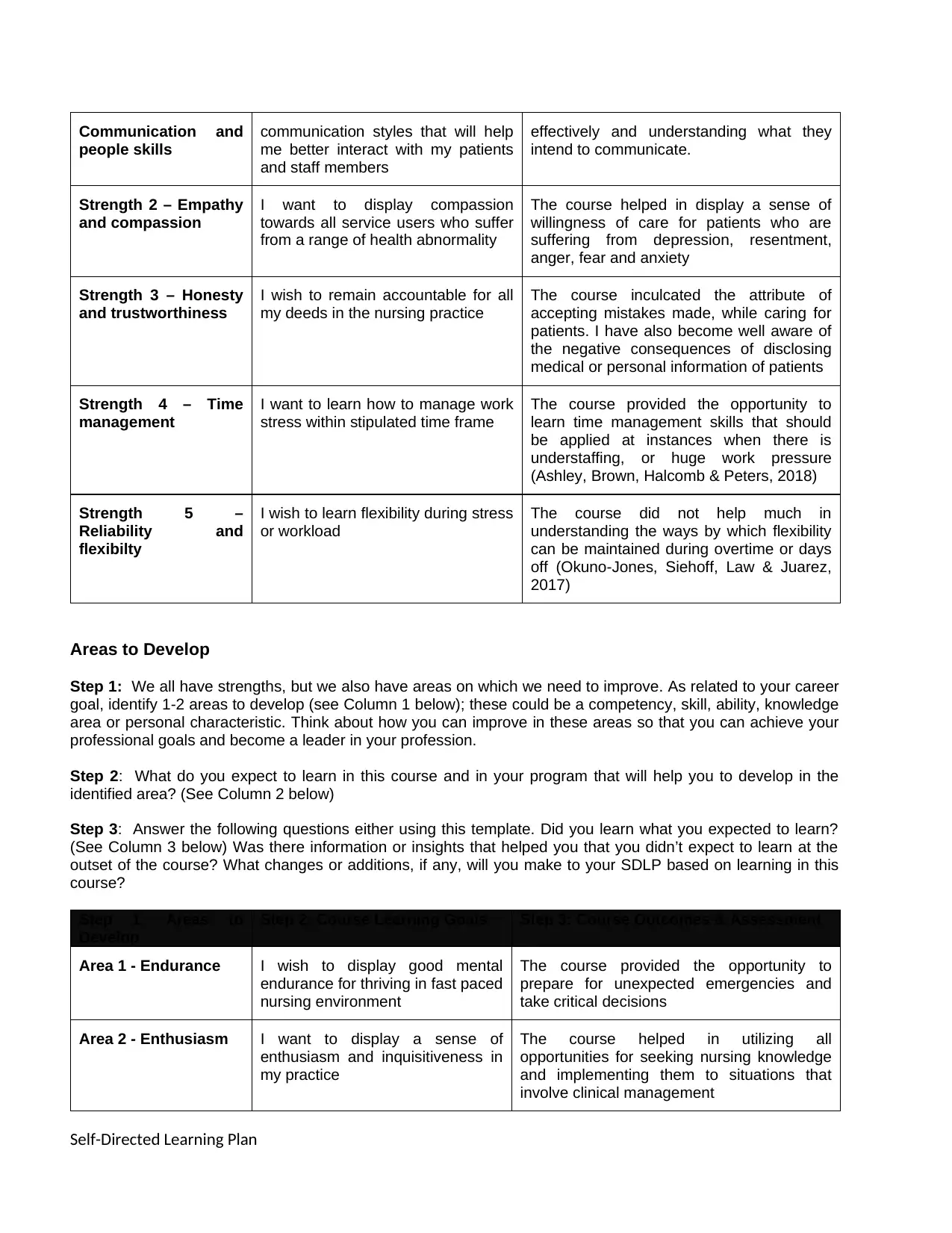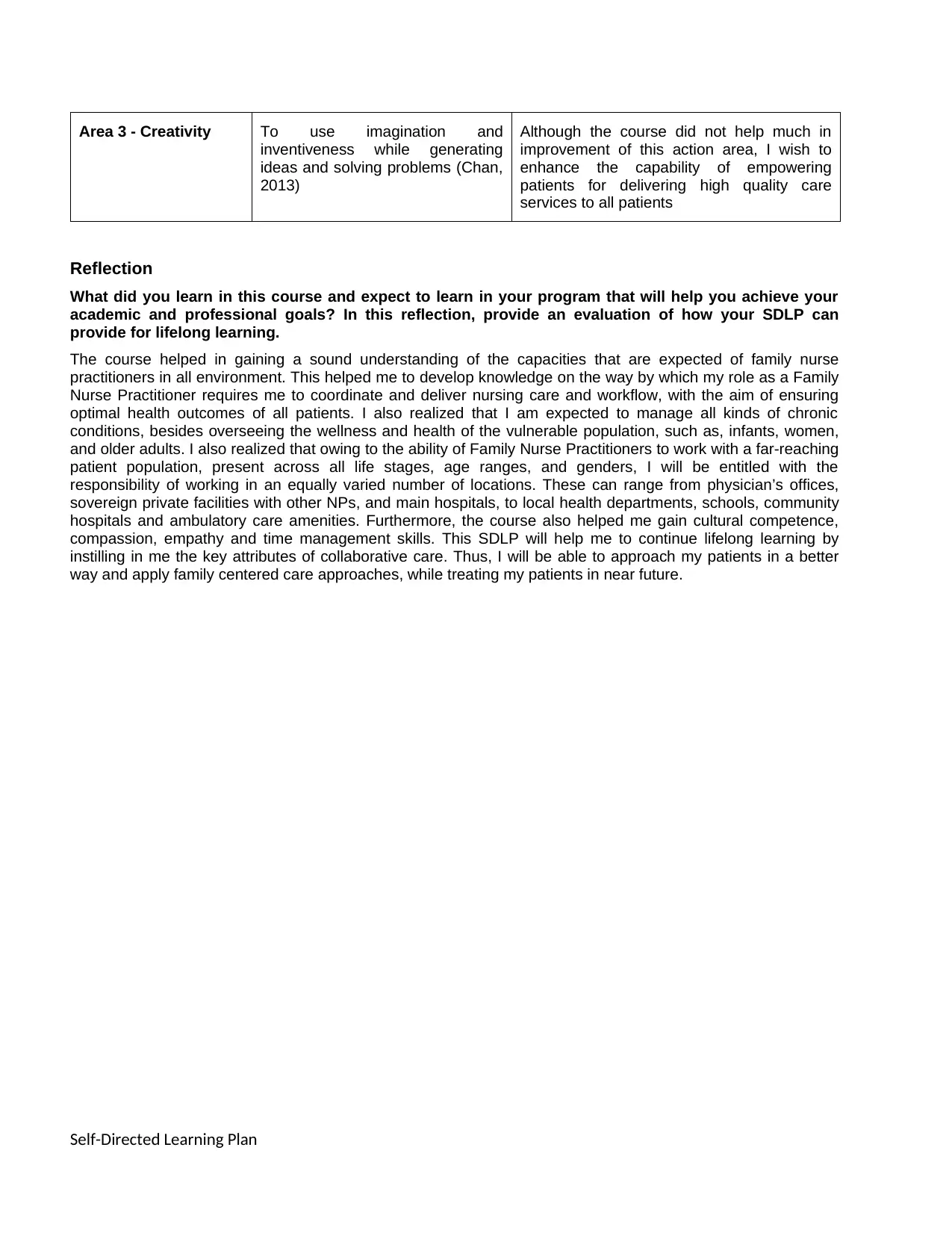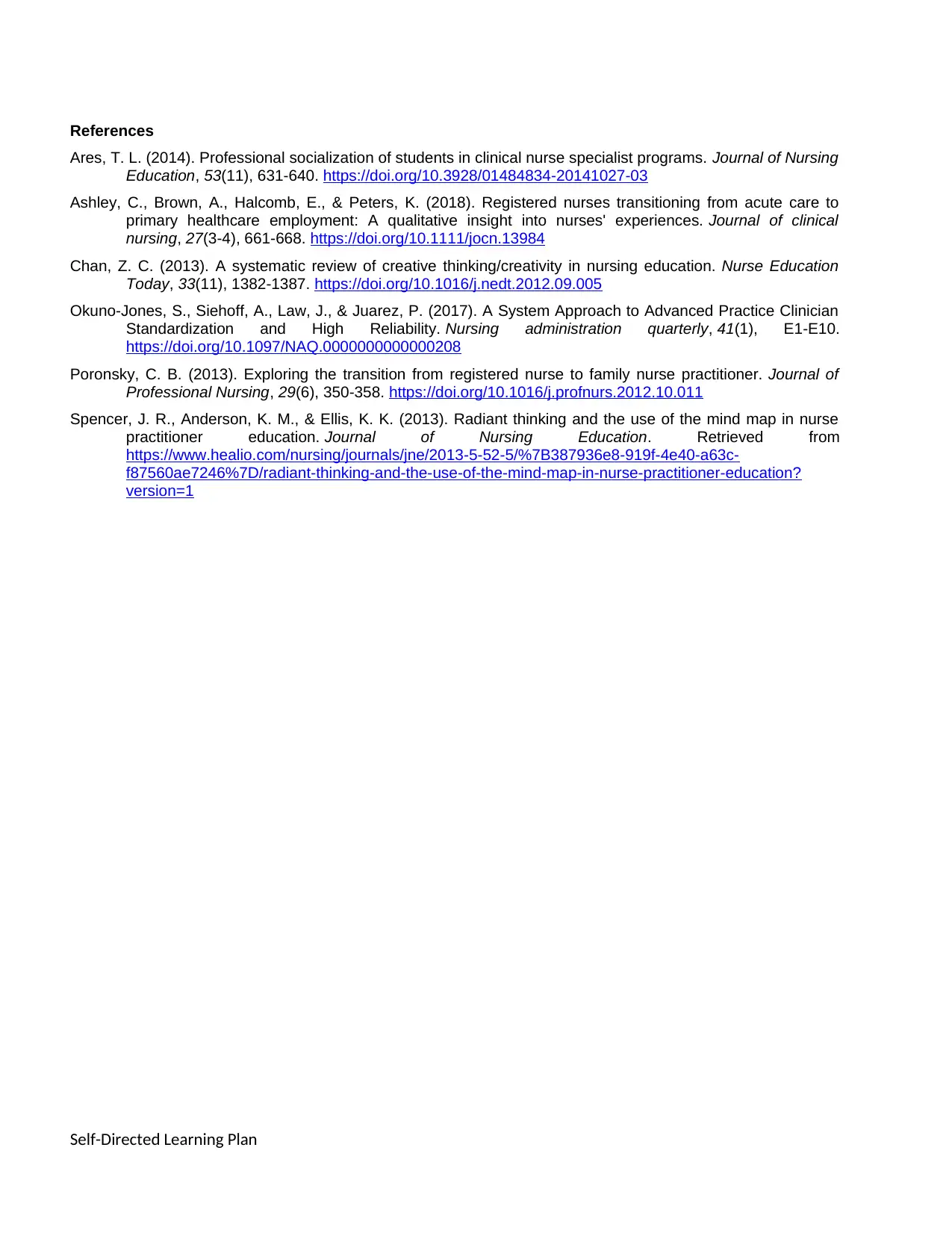Graduate Nursing: Self-Directed Learning Plan & Career Objectives
VerifiedAdded on 2023/05/29
|5
|1916
|233
Report
AI Summary
This assignment showcases a student's Self-Directed Learning Plan (SDLP) designed to chronicle accomplishments and learning steps towards becoming a Family Nurse Practitioner. The plan identifies knowledge, skills, and accomplishments necessary for an advanced nursing role, emphasizing the importance of communication, critical thinking, and leadership. The student leverages strengths like communication, empathy, honesty, and time management, while focusing on developing endurance, enthusiasm, and creativity. The reflection highlights the importance of cultural competence, compassion, and time management skills, indicating how the SDLP facilitates lifelong learning through collaborative care and family-centered approaches. References to relevant research articles support the plan's focus on professional socialization, transition from acute care, and creative thinking in nursing education.

SELF-DIRECTED LEARNING PLAN
The Self-Directed Learning Plan (SDLP) is a process and document to chronicle your accomplishments and
learning steps through the graduate program and beyond as they relate to your professional goals.
The SDLP will help you to identify and target the array of competencies you need to reach your professional
objectives and to help you organize your graduate learning experience to suit your career objectives.
The SDLP will be a section of your Program Portfolio, so take some quality introspective time to consider
strengths and areas of development relevant to your career objectives. Knowing your strengths and areas to
develop, you can begin a plan to find out what you need to do to achieve your career goals. We encourage you
to continue to reflect on the identified areas throughout the program. If you feel a strength or development area
is no longer relevant, you may add another to take its place. At any time, you may also add additional areas.
Your Name: Date:
Anticipated Nursing Role: Family Nurse Practitioner
Professional Goal (3-5 years) from now: I want to deliver primary health care services in an efficient manner
to patients belonging to all age groups.
I intend to complete a master level program for nursing that will place due emphasis on clinical experience and
advanced practice instruction
I wish to acquire license and set up a private practice for providing care services to all patients, regardless of
their cultural or socioeconomic background.
Knowledge that prepares a graduate student for an advanced nursing role (minimum of three items):
1. Masters education prepares a graduate nursing student for the future role as an advanced treatment
practitioner
2. Prove a comprehensive information of relevant exploration literature related to a selected specialty field of
advanced nursing practice
3. Ability to examine key communal and political effects on the delivery of professional and advanced practice
nursing facility
4. Knowledge and assistances required for the sustenance of addition to practice and the growth of healing and
evidence-based treatment interventions in advanced nursing practice
5.Knowledge on the need for a culturally competent practice in advanced nursing.
Skills that prepare a graduate student for an advanced nursing role (minimum of three items):
Self-Directed Learning Plan
The Self-Directed Learning Plan (SDLP) is a process and document to chronicle your accomplishments and
learning steps through the graduate program and beyond as they relate to your professional goals.
The SDLP will help you to identify and target the array of competencies you need to reach your professional
objectives and to help you organize your graduate learning experience to suit your career objectives.
The SDLP will be a section of your Program Portfolio, so take some quality introspective time to consider
strengths and areas of development relevant to your career objectives. Knowing your strengths and areas to
develop, you can begin a plan to find out what you need to do to achieve your career goals. We encourage you
to continue to reflect on the identified areas throughout the program. If you feel a strength or development area
is no longer relevant, you may add another to take its place. At any time, you may also add additional areas.
Your Name: Date:
Anticipated Nursing Role: Family Nurse Practitioner
Professional Goal (3-5 years) from now: I want to deliver primary health care services in an efficient manner
to patients belonging to all age groups.
I intend to complete a master level program for nursing that will place due emphasis on clinical experience and
advanced practice instruction
I wish to acquire license and set up a private practice for providing care services to all patients, regardless of
their cultural or socioeconomic background.
Knowledge that prepares a graduate student for an advanced nursing role (minimum of three items):
1. Masters education prepares a graduate nursing student for the future role as an advanced treatment
practitioner
2. Prove a comprehensive information of relevant exploration literature related to a selected specialty field of
advanced nursing practice
3. Ability to examine key communal and political effects on the delivery of professional and advanced practice
nursing facility
4. Knowledge and assistances required for the sustenance of addition to practice and the growth of healing and
evidence-based treatment interventions in advanced nursing practice
5.Knowledge on the need for a culturally competent practice in advanced nursing.
Skills that prepare a graduate student for an advanced nursing role (minimum of three items):
Self-Directed Learning Plan
Paraphrase This Document
Need a fresh take? Get an instant paraphrase of this document with our AI Paraphraser

•The aptitude for seeking information, its retrieval and assessment
•Analytical and critical thinking skills
• Demonstration of an openness to novel ideas for pharmacological and non-pharmacological interventions
• Adequate capability to interconnect systematic knowledge, with the help of written, oral, and web based media
• Demonstration of professional leadership skills
•Ability of translating the collected evidences into practice (Poronsky, 2013)
•Building and leading effective collaborative practice among inter-professional care teams
Accomplishments that prepare a graduate student for an advanced nursing role (minimum of three
items):
1. Communication and relationship management
2.MSN degree
3.Knowledge of the contemporary healthcare environment (Spencer, Anderson & Ellis, 2013)
4.Abiity to successfully implement change management
5.Competence in demonstration of advocacy, ethics, career planning and personal and/or professional
accountability (Ares, 2014)
Strengths to Leverage
Step 1: The most effective and satisfied people align their work with their natural strong points. Identify 3-5 of
your key strengths (see Column 1 below); these could be a competency, skill, ability, knowledge area or
personal characteristic. Think about how you can leverage those strengths to be effective in your work, achieve
your professional goals, and become a leader in your profession.
Step 2: At the beginning of each course in your graduate program, answer the following question either using
this template or a narrative format. What do you expect to learn in this course and in your program that will help
you leverage your strengths? (See Column 2 below) Be as specific as you can, e.g., assume that a strength is
your analytical ability.
Step 3: Answer the following questions either using this template or a narrative format. Did you learn what you
expected to learn? (See Column 3 below) Was there information or insights that helped you that you didn’t
expect to learn at the outset of the course? What changes or additions, if any, will you make to your SDLP
based on learning in this course?
Step 1: Strengths to
Leverage
Step 2: Course Learning Goals Step 3: Course Outcomes &
Assessment
Strength 1 – I intend to learn the different I have been able to speak with the patients
Self-Directed Learning Plan
•Analytical and critical thinking skills
• Demonstration of an openness to novel ideas for pharmacological and non-pharmacological interventions
• Adequate capability to interconnect systematic knowledge, with the help of written, oral, and web based media
• Demonstration of professional leadership skills
•Ability of translating the collected evidences into practice (Poronsky, 2013)
•Building and leading effective collaborative practice among inter-professional care teams
Accomplishments that prepare a graduate student for an advanced nursing role (minimum of three
items):
1. Communication and relationship management
2.MSN degree
3.Knowledge of the contemporary healthcare environment (Spencer, Anderson & Ellis, 2013)
4.Abiity to successfully implement change management
5.Competence in demonstration of advocacy, ethics, career planning and personal and/or professional
accountability (Ares, 2014)
Strengths to Leverage
Step 1: The most effective and satisfied people align their work with their natural strong points. Identify 3-5 of
your key strengths (see Column 1 below); these could be a competency, skill, ability, knowledge area or
personal characteristic. Think about how you can leverage those strengths to be effective in your work, achieve
your professional goals, and become a leader in your profession.
Step 2: At the beginning of each course in your graduate program, answer the following question either using
this template or a narrative format. What do you expect to learn in this course and in your program that will help
you leverage your strengths? (See Column 2 below) Be as specific as you can, e.g., assume that a strength is
your analytical ability.
Step 3: Answer the following questions either using this template or a narrative format. Did you learn what you
expected to learn? (See Column 3 below) Was there information or insights that helped you that you didn’t
expect to learn at the outset of the course? What changes or additions, if any, will you make to your SDLP
based on learning in this course?
Step 1: Strengths to
Leverage
Step 2: Course Learning Goals Step 3: Course Outcomes &
Assessment
Strength 1 – I intend to learn the different I have been able to speak with the patients
Self-Directed Learning Plan

Communication and
people skills
communication styles that will help
me better interact with my patients
and staff members
effectively and understanding what they
intend to communicate.
Strength 2 – Empathy
and compassion
I want to display compassion
towards all service users who suffer
from a range of health abnormality
The course helped in display a sense of
willingness of care for patients who are
suffering from depression, resentment,
anger, fear and anxiety
Strength 3 – Honesty
and trustworthiness
I wish to remain accountable for all
my deeds in the nursing practice
The course inculcated the attribute of
accepting mistakes made, while caring for
patients. I have also become well aware of
the negative consequences of disclosing
medical or personal information of patients
Strength 4 – Time
management
I want to learn how to manage work
stress within stipulated time frame
The course provided the opportunity to
learn time management skills that should
be applied at instances when there is
understaffing, or huge work pressure
(Ashley, Brown, Halcomb & Peters, 2018)
Strength 5 –
Reliability and
flexibilty
I wish to learn flexibility during stress
or workload
The course did not help much in
understanding the ways by which flexibility
can be maintained during overtime or days
off (Okuno-Jones, Siehoff, Law & Juarez,
2017)
Areas to Develop
Step 1: We all have strengths, but we also have areas on which we need to improve. As related to your career
goal, identify 1-2 areas to develop (see Column 1 below); these could be a competency, skill, ability, knowledge
area or personal characteristic. Think about how you can improve in these areas so that you can achieve your
professional goals and become a leader in your profession.
Step 2: What do you expect to learn in this course and in your program that will help you to develop in the
identified area? (See Column 2 below)
Step 3: Answer the following questions either using this template. Did you learn what you expected to learn?
(See Column 3 below) Was there information or insights that helped you that you didn’t expect to learn at the
outset of the course? What changes or additions, if any, will you make to your SDLP based on learning in this
course?
Step 1: Areas to
Develop
Step 2: Course Learning Goals Step 3: Course Outcomes & Assessment
Area 1 - Endurance I wish to display good mental
endurance for thriving in fast paced
nursing environment
The course provided the opportunity to
prepare for unexpected emergencies and
take critical decisions
Area 2 - Enthusiasm I want to display a sense of
enthusiasm and inquisitiveness in
my practice
The course helped in utilizing all
opportunities for seeking nursing knowledge
and implementing them to situations that
involve clinical management
Self-Directed Learning Plan
people skills
communication styles that will help
me better interact with my patients
and staff members
effectively and understanding what they
intend to communicate.
Strength 2 – Empathy
and compassion
I want to display compassion
towards all service users who suffer
from a range of health abnormality
The course helped in display a sense of
willingness of care for patients who are
suffering from depression, resentment,
anger, fear and anxiety
Strength 3 – Honesty
and trustworthiness
I wish to remain accountable for all
my deeds in the nursing practice
The course inculcated the attribute of
accepting mistakes made, while caring for
patients. I have also become well aware of
the negative consequences of disclosing
medical or personal information of patients
Strength 4 – Time
management
I want to learn how to manage work
stress within stipulated time frame
The course provided the opportunity to
learn time management skills that should
be applied at instances when there is
understaffing, or huge work pressure
(Ashley, Brown, Halcomb & Peters, 2018)
Strength 5 –
Reliability and
flexibilty
I wish to learn flexibility during stress
or workload
The course did not help much in
understanding the ways by which flexibility
can be maintained during overtime or days
off (Okuno-Jones, Siehoff, Law & Juarez,
2017)
Areas to Develop
Step 1: We all have strengths, but we also have areas on which we need to improve. As related to your career
goal, identify 1-2 areas to develop (see Column 1 below); these could be a competency, skill, ability, knowledge
area or personal characteristic. Think about how you can improve in these areas so that you can achieve your
professional goals and become a leader in your profession.
Step 2: What do you expect to learn in this course and in your program that will help you to develop in the
identified area? (See Column 2 below)
Step 3: Answer the following questions either using this template. Did you learn what you expected to learn?
(See Column 3 below) Was there information or insights that helped you that you didn’t expect to learn at the
outset of the course? What changes or additions, if any, will you make to your SDLP based on learning in this
course?
Step 1: Areas to
Develop
Step 2: Course Learning Goals Step 3: Course Outcomes & Assessment
Area 1 - Endurance I wish to display good mental
endurance for thriving in fast paced
nursing environment
The course provided the opportunity to
prepare for unexpected emergencies and
take critical decisions
Area 2 - Enthusiasm I want to display a sense of
enthusiasm and inquisitiveness in
my practice
The course helped in utilizing all
opportunities for seeking nursing knowledge
and implementing them to situations that
involve clinical management
Self-Directed Learning Plan
⊘ This is a preview!⊘
Do you want full access?
Subscribe today to unlock all pages.

Trusted by 1+ million students worldwide

Area 3 - Creativity To use imagination and
inventiveness while generating
ideas and solving problems (Chan,
2013)
Although the course did not help much in
improvement of this action area, I wish to
enhance the capability of empowering
patients for delivering high quality care
services to all patients
Reflection
What did you learn in this course and expect to learn in your program that will help you achieve your
academic and professional goals? In this reflection, provide an evaluation of how your SDLP can
provide for lifelong learning.
The course helped in gaining a sound understanding of the capacities that are expected of family nurse
practitioners in all environment. This helped me to develop knowledge on the way by which my role as a Family
Nurse Practitioner requires me to coordinate and deliver nursing care and workflow, with the aim of ensuring
optimal health outcomes of all patients. I also realized that I am expected to manage all kinds of chronic
conditions, besides overseeing the wellness and health of the vulnerable population, such as, infants, women,
and older adults. I also realized that owing to the ability of Family Nurse Practitioners to work with a far-reaching
patient population, present across all life stages, age ranges, and genders, I will be entitled with the
responsibility of working in an equally varied number of locations. These can range from physician’s offices,
sovereign private facilities with other NPs, and main hospitals, to local health departments, schools, community
hospitals and ambulatory care amenities. Furthermore, the course also helped me gain cultural competence,
compassion, empathy and time management skills. This SDLP will help me to continue lifelong learning by
instilling in me the key attributes of collaborative care. Thus, I will be able to approach my patients in a better
way and apply family centered care approaches, while treating my patients in near future.
Self-Directed Learning Plan
inventiveness while generating
ideas and solving problems (Chan,
2013)
Although the course did not help much in
improvement of this action area, I wish to
enhance the capability of empowering
patients for delivering high quality care
services to all patients
Reflection
What did you learn in this course and expect to learn in your program that will help you achieve your
academic and professional goals? In this reflection, provide an evaluation of how your SDLP can
provide for lifelong learning.
The course helped in gaining a sound understanding of the capacities that are expected of family nurse
practitioners in all environment. This helped me to develop knowledge on the way by which my role as a Family
Nurse Practitioner requires me to coordinate and deliver nursing care and workflow, with the aim of ensuring
optimal health outcomes of all patients. I also realized that I am expected to manage all kinds of chronic
conditions, besides overseeing the wellness and health of the vulnerable population, such as, infants, women,
and older adults. I also realized that owing to the ability of Family Nurse Practitioners to work with a far-reaching
patient population, present across all life stages, age ranges, and genders, I will be entitled with the
responsibility of working in an equally varied number of locations. These can range from physician’s offices,
sovereign private facilities with other NPs, and main hospitals, to local health departments, schools, community
hospitals and ambulatory care amenities. Furthermore, the course also helped me gain cultural competence,
compassion, empathy and time management skills. This SDLP will help me to continue lifelong learning by
instilling in me the key attributes of collaborative care. Thus, I will be able to approach my patients in a better
way and apply family centered care approaches, while treating my patients in near future.
Self-Directed Learning Plan
Paraphrase This Document
Need a fresh take? Get an instant paraphrase of this document with our AI Paraphraser

References
Ares, T. L. (2014). Professional socialization of students in clinical nurse specialist programs. Journal of Nursing
Education, 53(11), 631-640. https://doi.org/10.3928/01484834-20141027-03
Ashley, C., Brown, A., Halcomb, E., & Peters, K. (2018). Registered nurses transitioning from acute care to
primary healthcare employment: A qualitative insight into nurses' experiences. Journal of clinical
nursing, 27(3-4), 661-668. https://doi.org/10.1111/jocn.13984
Chan, Z. C. (2013). A systematic review of creative thinking/creativity in nursing education. Nurse Education
Today, 33(11), 1382-1387. https://doi.org/10.1016/j.nedt.2012.09.005
Okuno-Jones, S., Siehoff, A., Law, J., & Juarez, P. (2017). A System Approach to Advanced Practice Clinician
Standardization and High Reliability. Nursing administration quarterly, 41(1), E1-E10.
https://doi.org/10.1097/NAQ.0000000000000208
Poronsky, C. B. (2013). Exploring the transition from registered nurse to family nurse practitioner. Journal of
Professional Nursing, 29(6), 350-358. https://doi.org/10.1016/j.profnurs.2012.10.011
Spencer, J. R., Anderson, K. M., & Ellis, K. K. (2013). Radiant thinking and the use of the mind map in nurse
practitioner education. Journal of Nursing Education. Retrieved from
https://www.healio.com/nursing/journals/jne/2013-5-52-5/%7B387936e8-919f-4e40-a63c-
f87560ae7246%7D/radiant-thinking-and-the-use-of-the-mind-map-in-nurse-practitioner-education?
version=1
Self-Directed Learning Plan
Ares, T. L. (2014). Professional socialization of students in clinical nurse specialist programs. Journal of Nursing
Education, 53(11), 631-640. https://doi.org/10.3928/01484834-20141027-03
Ashley, C., Brown, A., Halcomb, E., & Peters, K. (2018). Registered nurses transitioning from acute care to
primary healthcare employment: A qualitative insight into nurses' experiences. Journal of clinical
nursing, 27(3-4), 661-668. https://doi.org/10.1111/jocn.13984
Chan, Z. C. (2013). A systematic review of creative thinking/creativity in nursing education. Nurse Education
Today, 33(11), 1382-1387. https://doi.org/10.1016/j.nedt.2012.09.005
Okuno-Jones, S., Siehoff, A., Law, J., & Juarez, P. (2017). A System Approach to Advanced Practice Clinician
Standardization and High Reliability. Nursing administration quarterly, 41(1), E1-E10.
https://doi.org/10.1097/NAQ.0000000000000208
Poronsky, C. B. (2013). Exploring the transition from registered nurse to family nurse practitioner. Journal of
Professional Nursing, 29(6), 350-358. https://doi.org/10.1016/j.profnurs.2012.10.011
Spencer, J. R., Anderson, K. M., & Ellis, K. K. (2013). Radiant thinking and the use of the mind map in nurse
practitioner education. Journal of Nursing Education. Retrieved from
https://www.healio.com/nursing/journals/jne/2013-5-52-5/%7B387936e8-919f-4e40-a63c-
f87560ae7246%7D/radiant-thinking-and-the-use-of-the-mind-map-in-nurse-practitioner-education?
version=1
Self-Directed Learning Plan
1 out of 5
Related Documents
Your All-in-One AI-Powered Toolkit for Academic Success.
+13062052269
info@desklib.com
Available 24*7 on WhatsApp / Email
![[object Object]](/_next/static/media/star-bottom.7253800d.svg)
Unlock your academic potential
Copyright © 2020–2026 A2Z Services. All Rights Reserved. Developed and managed by ZUCOL.





